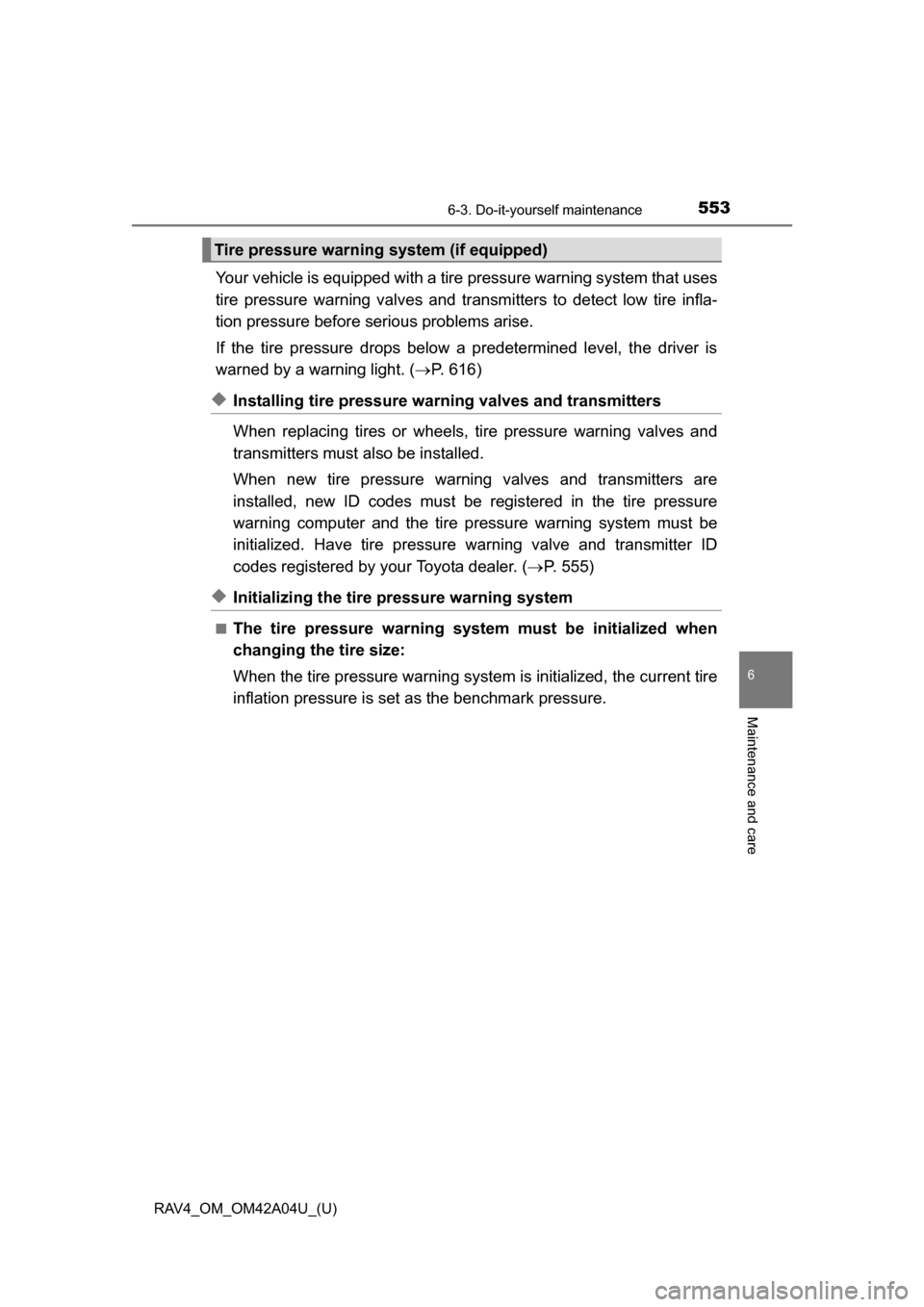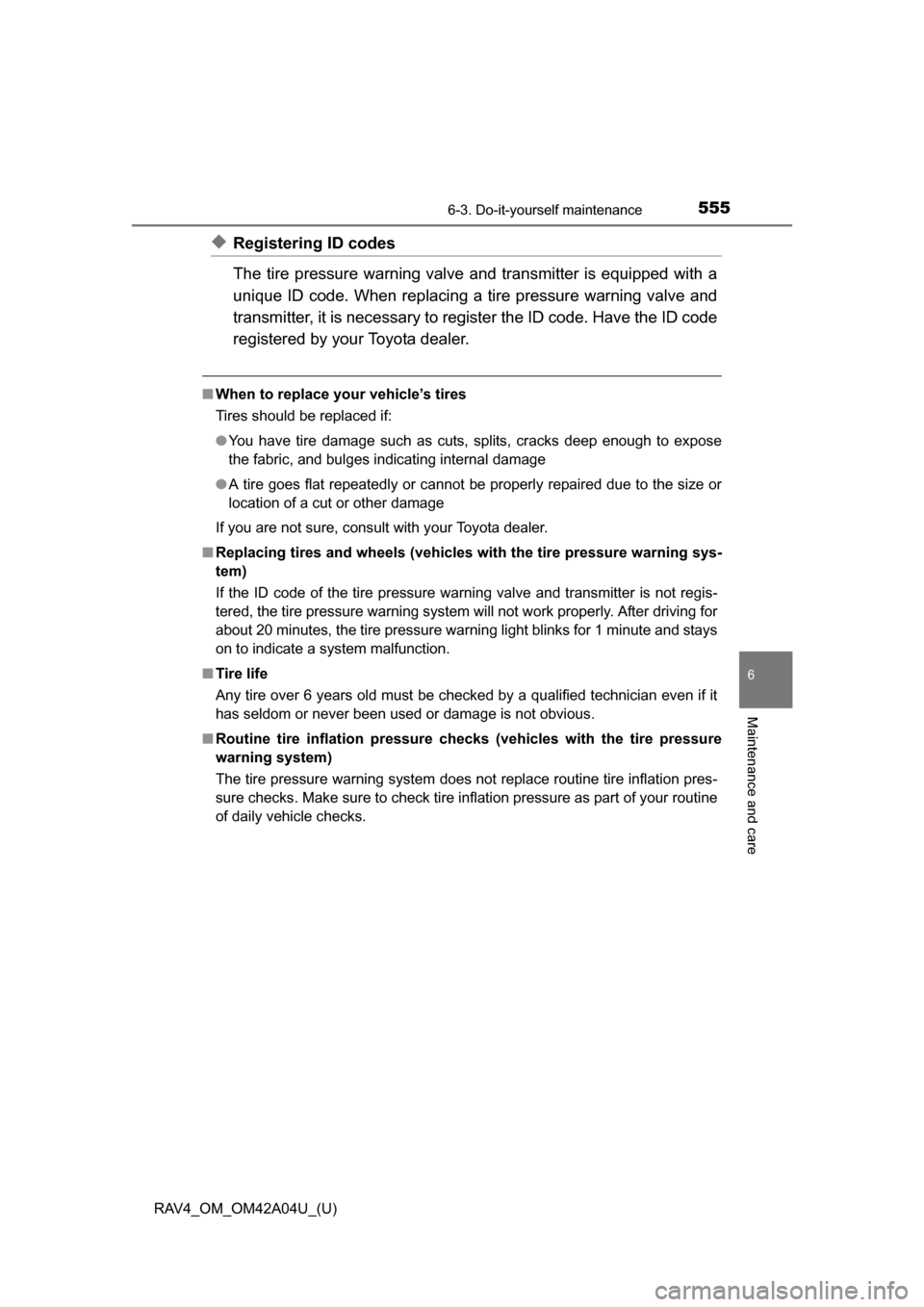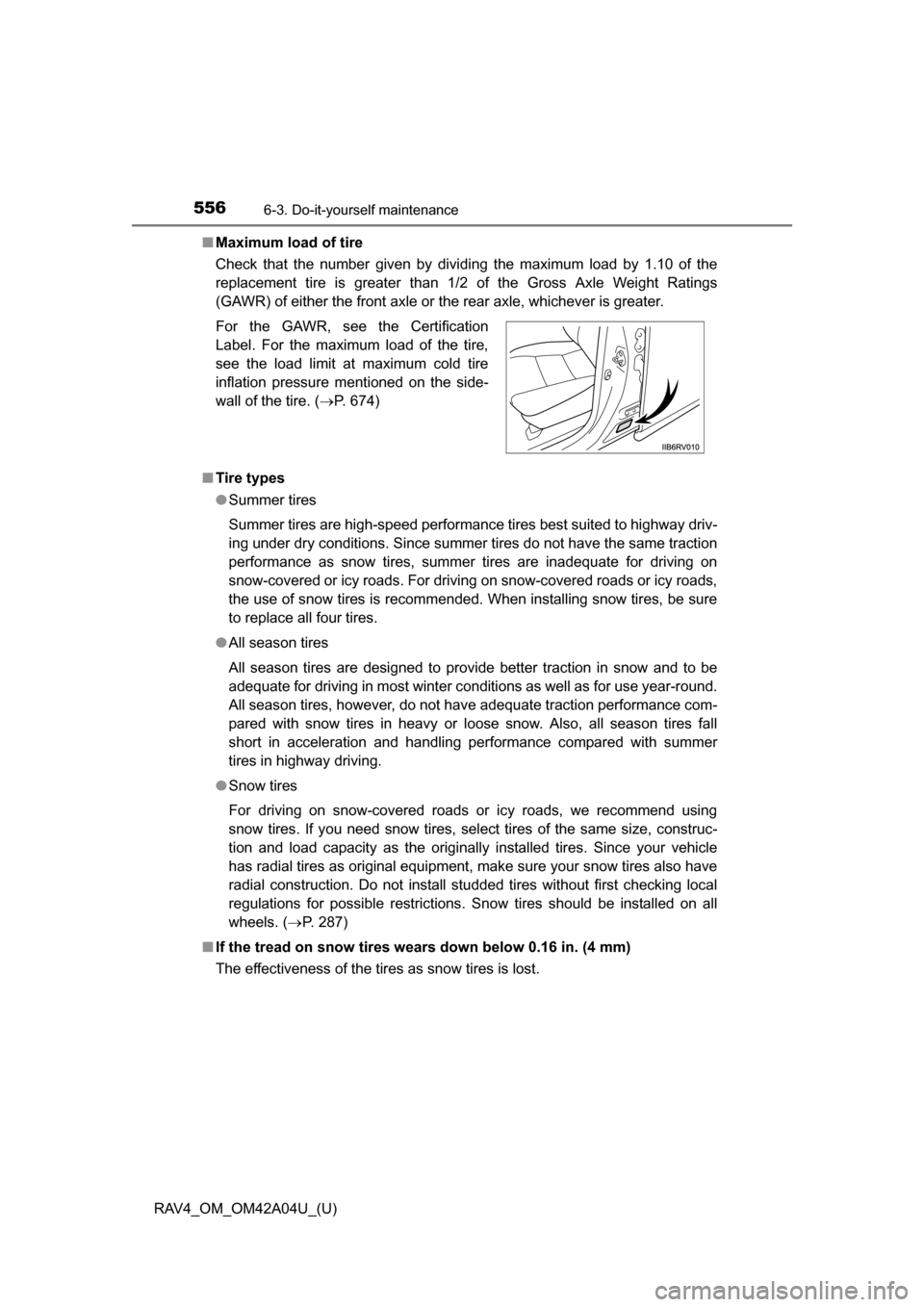Page 511 of 732
511
RAV4_OM_OM42A04U_(U)
6Maintenance and care
6-1. Maintenance and careCleaning and protecting the vehicle exterior .......... 512
Cleaning and protecting the vehicle interior ........... 516
6-2. Maintenance Maintenance requirements ................... 520
General maintenance........ 523
Emission inspection and maintenance (I/M)
programs ......................... 527
6-3. Do-it-yourself maintenance Do-it-yourself service precautions ..................... 528
Hood ................................. 533
Positioning a floor jack ...... 535
Engine compartment ......... 537
Tires .................................. 551
Tire inflation pressure ....... 562
Wheels .............................. 565
Air conditioning filter.......... 568
Wireless remote control/electronic
key battery ...................... 570
Checking and replacing fuses ............................... 573
Light bulbs......................... 584
Page 526 of 732
526
RAV4_OM_OM42A04U_(U)
6-2. Maintenance
Vehicle exterior
ItemsCheck points
Doors• Do the doors operate smoothly?
Engine hood• Does the engine hood lock systemwork properly?
Fluid leaks
• There should not be any signs offluid leakage after the vehicle has
been parked.
Tires
• Is the tire inflation pressure cor-rect?
• The tires should not be dam- aged or excessively worn.
• Have the tires been rotated according to the maintenance
schedule?
• The wheel nuts should not be loose.
Windshield wipers/rear window
wiper
• The wiper blades should notshow any signs of cracking,
splitting, wear, contamination or
deformation.
• The wiper blades should clear the windshield/r ear window with-
out streaking or skipping.
CAUTION
■ If the engine is running
Turn the engine off and ensure that there is adequate ventilation before per-
forming maintenance checks.
Page 551 of 732
551
RAV4_OM_OM42A04U_(U)
6-3. Do-it-yourself maintenance
6
Maintenance and care
Tires
New tread
Treadwear indicator
Worn tread
The location of treadwear indica-
tors is shown by the “TWI” or “”
marks, etc., molded on the sidewall
of each tire.
Check spare tire condition and
pressure if not rotated.
Replace or rotate tires in acco rdance with maintenance sched-
ules and treadwear.
Checking tires
1
2
3
Page 552 of 732
552
RAV4_OM_OM42A04U_(U)
6-3. Do-it-yourself maintenance
Rotate the tires in the order shown.
Do not fail to initialize the tire pressure warning system after tire rotation.
To equalize tire wear and extend tire life, Toyota recommends that tire rota-
tion is carried out at the same interval as tire inspection.
Tire rotation
Vehicles with compact spare
tireVehicles with full-size spare
tire
FrontFront
Page 553 of 732

RAV4_OM_OM42A04U_(U)
5536-3. Do-it-yourself maintenance
6
Maintenance and care
Your vehicle is equipped with a tire pressure warning system that uses
tire pressure warning valves and tr ansmitters to detect low tire infla-
tion pressure before serious problems arise.
If the tire pressure drops below a predetermined level, the driver is
warned by a warning light. ( P. 616)
◆Installing tire pressure warning valves and transmitters
When replacing tires or wheels, tire pressure warning valves and
transmitters must also be installed.
When new tire pressure warning valves and transmitters are
installed, new ID codes must be registered in the tire pressure
warning computer and the tire pr essure warning system must be
initialized. Have tire pressure warning valve and transmitter ID
codes registered by your Toyota dealer. ( P. 555)
◆Initializing the tire pressure warning system
■The tire pressure warning system must be initialized when
changing the tire size:
When the tire pressure warning system is initialized, the current tire
inflation pressure is set as the benchmark pressure.
Tire pressure warning system (if equipped)
Page 555 of 732

RAV4_OM_OM42A04U_(U)
5556-3. Do-it-yourself maintenance
6
Maintenance and care
◆Registering ID codes
The tire pressure warning valve and transmitter is equipped with a
unique ID code. When replacing a tire pressure warning valve and
transmitter, it is necessary to register the ID code. Have the ID code
registered by your Toyota dealer.
■When to replace your vehicle’s tires
Tires should be replaced if:
●You have tire damage such as cuts, splits, cracks deep enough to expose
the fabric, and bulges indicating internal damage
● A tire goes flat repeatedly or cannot be properly repaired due to the size or
location of a cut or other damage
If you are not sure, consult with your Toyota dealer.
■ Replacing tires and wheels (vehicles with the tire pressure warning sys-
tem)
If the ID code of the tire pressure warning valve and transmitter is not regis-
tered, the tire pressure warning system will not work properly. After driving for
about 20 minutes, the tire pressure warning light blinks for 1 minute and stays
on to indicate a system malfunction.
■ Tire life
Any tire over 6 years old must be checked by a qualified technician even if it
has seldom or never been used or damage is not obvious.
■ Routine tire inflation pressure checks (vehicles with the tire pressure
warning system)
The tire pressure warning system does not replace routine tire inflation pres-
sure checks. Make sure to check tire inflation pressure as part of your routine
of daily vehicle checks.
Page 556 of 732

556
RAV4_OM_OM42A04U_(U)
6-3. Do-it-yourself maintenance
■Maximum load of tire
Check that the number given by dividing the maximum load by 1.10 of the
replacement tire is greater than 1/2 of the Gross Axle Weight Ratings
(GAWR) of either the front axle or the rear axle, whichever is greater.
■ Tire types
●Summer tires
Summer tires are high-speed performance tires best suited to highway driv-
ing under dry conditions. Since summer tires do not have the same traction
performance as snow tires, summer tires are inadequate for driving on
snow-covered or icy roads. For driving on snow-covered roads or icy roads,
the use of snow tires is recommended. When installing snow tires, be sure
to replace all four tires.
● All season tires
All season tires are designed to provide better traction in snow and to be
adequate for driving in most winter conditions as well as for use year-round.
All season tires, however, do not have adequate traction performance com-
pared with snow tires in heavy or loose snow. Also, all season tires fall
short in acceleration and handling performance compared with summer
tires in highway driving.
● Snow tires
For driving on snow-covered roads or icy roads, we recommend using
snow tires. If you need snow tires, select tires of the same size, construc-
tion and load capacity as the originally installed tires. Since your vehicle
has radial tires as original equipment, make sure your snow tires also have
radial construction. Do not install studded tires without first checking local
regulations for possible restrictions. Snow tires should be installed on all
wheels. ( P. 287)
■ If the tread on snow tires wears down below 0.16 in. (4 mm)
The effectiveness of the tires as snow tires is lost. For the GAWR, see the Certification
Label. For the maximum load of the tire,
see the load limit at maximum cold tire
inflation pressure mentioned on the side-
wall of the tire. ( P. 674)
Page 558 of 732

558
RAV4_OM_OM42A04U_(U)
6-3. Do-it-yourself maintenance
■The initialization operation (vehicles with the tire pressure warning sys-
tem)
●Make sure to carry out initialization after adjusting the tire inflation pressure.
Also, make sure the tires are cold before carrying out initialization or tire
inflation pressure adjustment.
● If you have accidentally turned the engine switch to the “LOCK” position
(vehicles without a smart key system) or off (vehicles with a smart key sys-
tem) during initialization, it is not necessary to press the reset switch again
as initialization will restart automatically when the engine switch has been
turned to the “ON” position (vehicles without a smart key system) or IGNI-
TION ON mode (vehicles with a smart key system) for the next time.
● If you accidentally press the reset switch when initialization is not necessary,
adjust the tire inflation pressure to the specified level when the tires are
cold, and conduct initialization again.
■ When initialization of the tire pressure warning system has failed (if
equipped)
Initialization can be completed in a few minutes. However, in the following
cases, the settings have not been recorded and the system will not operate
properly. If repeated attempts to record tire inflation pressure settings are
unsuccessful, have the vehicle inspected by your Toyota dealer.
● When operating the tire pressure warning reset switch, the tire pressure
warning light does not blink 3 times.
● After driving for a certain period of time since the initialization has been
completed, the warning light comes on after blinking for 1 minute.
■ Tire pressure warning system certification
For vehicles sold in the U.S.A.
TRW Automotive
Tire Pressure Monitoring Sensor
FCC ID: GQ4-51T
This device complies with Part 15 of the FCC Rules. Operation is subject to the
following two conditions: (1) This device may not cause harmful interference, and
(2) This device must accept any interfer ence received, including interference that
may cause undesired operation of this device.
WARNING: Changes or modifications not expressively approved by TRW Auto-
motive U.S. LLC could void the user’s authority to operate the equipment.